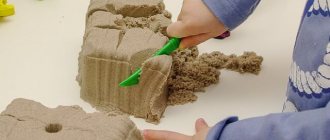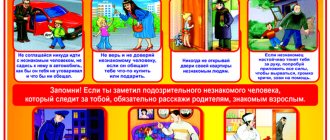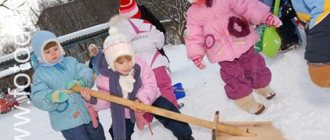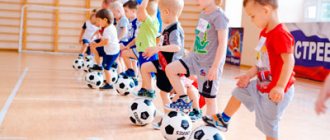Labor education of young children
Vera Gavrilova
Labor education of young children
The purpose of labor education: the formation of a positive attitude towards work.
Types of work:
•self-service;
•socially – useful work.
In younger groups, children’s work is organized in the form of individual assignments, which they carry out together with the teacher. Children need constant supervision. Due to their characteristics, children are not sufficiently independent in their actions, are prone to imitation, cannot yet coordinate their actions with the actions of their comrades, are often distracted, and do not finish what they start. Kids are little interested in the result; they are attracted by the process of action itself. They do not yet have the necessary skills and abilities to achieve results.
Therefore, the kids work together with the teacher: they help set the table, lay out materials for classes, water the plants, and collect vegetables in the garden. The adult takes on the most difficult work, leaving for the child what he can do. In the process of work, the teacher helps the child master the necessary skills, cope with emerging difficulties, and correct mistakes.
Tasks and content of self-service work:
1. Form the habit (first under the supervision of an adult, and then independently) of washing your hands when dirty and before eating, wiping your face and hands dry with a personal towel.
2. Learn to put yourself in order with the help of an adult.
3. Learn to use individual objects (handkerchief, napkin, towel, comb, pot).
4. Develop the ability to hold a spoon correctly while eating.
5. Teach children to dress and undress in a certain order; with a little help from an adult, remove clothes and shoes (unfasten front buttons, Velcro fasteners); Carefully fold removed clothes in a certain order. Accustom to neatness.
Socially useful work: tasks and content of work:
1. Involve children in performing simple labor actions: together with an adult and under his control, arrange bread bins (without bread, napkin holders, lay out spoons, etc.
2. To teach how to maintain order in the playroom and, at the end of the games, to place the play material in its place.
3. Encourage children's interest in adult activities. Pay attention to what an adult does and how, why he performs certain actions.
4. Learn to recognize and name some labor actions.
Term Contents of work
September
Week 1 - self-service - Game “We came to wash ourselves”
Week 2 – economic and household work – Conversation “Everything has its place”
Week 3 - work in nature - Involve children in filling water containers for settling water
Week 4 - joint work with adults - Involve children in helping the nanny (remove napkin holders and bread bins)
October
Week 1 – self-care – Exercise “Roll up our sleeves”
Week 2 – household chores – Game “Put the trash in the basket”
Week 3 – work in nature – Watering indoor plants
Week 4 – joint work with adults – Involving children in helping the teacher (preparation for the lesson); Involving children in helping the teacher (cleaning up fallen leaves on the site)
November
Week 1 – self-care – Exercise “Turn out your tights”
Week 2 – household chores – Exercise “Arranging the chairs”
Week 3 – work in nature – Spraying plants with water
Week 4 – joint work with adults - Targeted visit to the head nurse’s office, observation of the work of the head nurse; Involving children in helping the teacher (cleaning up fallen leaves on the site)
December
Week 1 - Self-Care - Button Up Exercise
Week 2 – household chores – Exercise “Lay out the pencils”
Week 3 – labor in nature – Wash the ficus leaves
Week 4 - joint work with adults - Help the nanny hang towels in the washroom; Involving children in helping the teacher (clearing snow on the site)
January
Week 2 – self-care – Exercise “We do everything in order”
Week 3 – household chores – Wipe off dust from toy shelves
Week 4 - joint work with adults - Helping the nanny set the tables for dinner (napkin holders and bread bins); Involving children in helping the teacher (clearing snow on the site)
February
1 week - self-service - Game "Odezhkin's House"
Week 2 – household chores – Wipe down toys
Week 3 – work in nature – Loosening indoor plants
Week 4 - joint work with adults - Help the teacher in washing doll clothes; Involving children in helping the teacher (clearing snow on the site)
March
Week 1 – self-care – Exercise “Let’s wash our hands”
Week 2 – household chores – Laying out books in the book corner
Week 3 – labor in nature – Planting large vegetable seeds
Week 4 - joint work with adults - Help the teacher in repairing books and educational games; Targeted visit to the canteen, observing the work of the cook
April
Week 1 – self-care – Exercise “Our things go to bed”
Week 2 – household chores – Remove building material after playing
Week 3 – work in nature – Watering indoor plants
Week 4 – joint work with adults – Helping the teacher prepare equipment for the lesson; Targeted visit to a laundress, observation of the work of a laundry worker
May
Week 1 – Self-Care – “We’ll Tuck Our T-Shirts” Game
Week 2 – household chores – Dress up the dolls in the doll corner
Week 3 – labor in nature – Wash plant leaves
Week 4 - joint work with adults - Helping the teacher in putting order in the play corners; Monitoring the work of the janitor.
Fostering work activity in children of primary preschool age is one of the most important results of work in kindergarten. It is at this age that the foundation for the formation of moral and labor qualities is laid.
Knowing the peculiarities of the organization of work, mastering methods and techniques with children of primary preschool age, students actively develop such personality qualities as hard work, humanity, respect for the work of peers and adults, and the results of their work. In addition, they develop a sense of friendship, responsiveness, independence, initiative, consciousness, etc.
Work assignments as a means of labor education for younger preschoolers
Labor orders are an appeal to a child with a request from an adult to perform some labor action. An assignment is the first form of organizing work activity. The research of V.G. was devoted to the study of this form. Nechaeva, A.T. Shatova. In different types of work assignments, various forms of its organization are used, teachers instill in children interest and love for work, teach them to carry out assignments and take care of materials [14].
Assignments are the simplest form of organizing the work activity of preschool children, therefore they are especially important at the lower stages of preschool age, when the child cannot yet work on his own initiative and the teacher, with the help of a variety of simple tasks, gradually teaches him to be useful to the team and peers. As research has shown (R.S. Bure), work assignments should be distinguished from duties, although many assignments already at the lower stages of preschool childhood are conventionally considered a duty: this is to maintain order in the premises and area of the kindergarten, to clean up things and toys after oneself, to dress independently , undress, fold clothes, care for plants and animals, etc. A special place is given to work assignments in the process of mental education. Based on the mental activity of preschool children, readiness for independent activity, work assignments contribute to the formation of analysis, planning, time concepts, and curiosity. Cultivating interest in work and the formation of child-conscious motives for activity are closely related to the development of purposefulness. Work assignments contribute to the formation of a desire to achieve certain goals [3].
In early preschool age, children mainly carry out individual assignments. The acquisition of skills will be facilitated by repetition and consolidation of methods of activity, and the constant introduction of younger preschoolers to assignments. As children gain independent experience in completing the task, the teacher should move on to verbal reminders. A conversation with children plays a special role, during which the task and how to complete it are discussed. It is important that all children participate in such discussions, showing activity and independence [5].
Labor training is carried out by the teacher when organizing the child’s individual activities, either in joint work with adults, or in special frontal classes, when there is a need to simultaneously teach a subgroup or group of children how to perform certain actions. By supervising the execution of assignments, the teacher studies the capabilities of the children in his group. In everyday work, involving them in performing simple tasks, he observes each child: he identifies the level of skills, the desire with which he takes on the task, the ability to complete the task independently. Constant control over the children’s activities allows the teacher to correctly implement an individual approach and take into account the child’s capabilities for actively involving him in work.
Labor assignments in kindergarten are varied. This allows children to maintain interest in activities and provide them with a comprehensive education. Through assignments, it is possible to solve the problems of not only labor education, but also moral, physical, mental and aesthetic ones. After all, only through work can a child develop comprehensively, reveal his capabilities and talents. It is very important to instill in a child respect for the work of adults from an early age, to raise a hardworking, modest and sympathetic person who strives to bring benefit with his work, to work for the good of society.
The teacher has certain methods: the word, direct demonstration of the method of making a manufactured sample, etc. Using these methods, he develops in children the ability to think logically, observe, compare, analyze, generalize, develop cognitive abilities, perception, memory, and accustom them to the points of business speech.
Job evaluation plays a special role when carrying out assignments. It is imperative to find something positive in the child’s behavior and activities even when he cannot cope with the task independently [9].
Familiarizing children with the work of adults and cultivating interest and respect for their work are of great importance. All these tasks contribute to the formation of the components of work activity: the formation of motives and goals of work, the determination of the objects and nature of work, the correct selection of tools and materials, the formation of work activity, and the ability to evaluate its results.
Work in preschool age is of great importance for the mental development of children: in the process of becoming familiar with the purposes, properties and qualities of materials and tools, mastering actions with them, planning a sequence of operations, perceptions, ideas, various forms of thinking and mental operations develop. In the process of labor education, children’s ideas about the life and occupations of people, the benefits and results of their work are expanded and concretized.
Labor also serves as a means of physical education for children, since visual-motor coordination and fine motor skills are developed, movements, their coordination and consistency are improved. The formation of arbitrariness of movements in the process of labor actions is important. Achieving work goals and their results bring joy to children and evoke an emotional response.
All these tasks contribute to the formation of components of work activity: the formation of motives and goals of work, the determination of objects and the nature of work, the correct selection of tools and materials, the formation of work activity, and the ability to evaluate its results [6].
Early introduction of children to useful work activities
The article analyzes the degree to which preschool children aged 4 to 5 years are involved in useful work activities. Based on the results of the study, the level of involvement of children in labor was revealed.
Key words: labor activity, diagnostics of useful labor, folk culture, traditional pedagogy, Russian folklore.
The article analyzes the degree of familiarizing children of preschool age from 4 to 5 years to the useful work. The study revealed a level of familiarizing children to work.
Keywords: labor activity, diagnostics useful labor, folk culture, traditional pedagogy, Russian folklore.
Currently, little attention is paid to the problem of developing useful work skills in preschool children. More and more often we can see how a child refuses to carry out instructions from his parents or teacher. Children have become more interested in spending time on phones and computers than in watering plants, imitating adults in cleaning, cooking, etc. The problem discussed in this article is relevant, since the situation of social development of society requires attention to the work activity of the individual, active participation in labor. The process of activating the human factor depends on the results of the formation of a value attitude towards work. Our task is to cultivate in the modern generation of children a positive attitude towards work, the ability and desire to complete the work started, and to encourage initiative in helping adults and peers.
Educational experience shows that often ignorance and ignorance of national characteristics, reflected in customs, traditions, and folk wisdom, leads to the fact that the national psychological characteristics of people come into conflict with the goals and methods of education. Labor education is the central problem of folk pedagogy and psychology; according to established popular ideas, the development of morality and intelligence, physical and aesthetic improvement of the individual occurs mainly in the conditions of labor activity.
In the dictionary of the Russian language by T. F. Efremov, work is a purposeful human activity, work that requires mental or physical stress, the expenditure of physical or mental energy. Hard work and the ability to work are not given by nature, but are cultivated from early childhood. Work must be creative, because it is creative work that makes a person spiritually rich. It provides an opportunity to show care for a loved one and develops physically. The ability to work, to create valuable and beautiful things with one’s own hands is the leading criterion for assessing a person, the basis of people’s opinion about a person. In addition, a child acquires many skills and abilities among his peers, primarily through games and fun.
Labor activity is an important means of personal development. Already at preschool age, the initial forms of labor activity develop. This is confirmed by the research of psychologists A. V. Zaporozhets, D. B. Elkonin, E. A. Klimov. As psychologists point out, this happens in two directions: the formation of prerequisites for work activity and the formation of work activity itself, in the formation of social motives of behavior. Ushinsky spoke about the work of preschool children: “Labor is the most important means of education, starting from preschool age; In the process, the child’s personality is formed and family relationships are formed. The entire process of raising children in kindergarten can and should be organized so that they learn to understand the benefits and necessity of work for themselves and the team. Treats work with love, seeing joy in it is a necessary condition for the manifestation of a person’s creativity and talents” [6].
It is difficult to objectively evaluate the work of a preschooler, but the child experiences real labor efforts and evaluates the work accordingly. Work captivates the child, allows him to feel his capabilities, and experience the joy of the results achieved.
There is no doubt that the core of Russian folk culture and pedagogy was Russian agricultural culture and traditional pedagogy. Most holidays and rituals were of an agricultural nature; children were early prepared for future work on the land and accustomed to hard work in the field, in the garden and around the house. As soon as the child grew up, he easily and naturally got involved in work. He was not forced, he was not forced to work, but he was interested in the work and allowed to do something on his own. A child's thirst for imitation is the most effective incentive to work. Already at 4–5 years old, the girl helped her sister wind threads and feed chickens; She started babysitting her brothers and sisters very early. A 6-7 year old child was trusted to drive the cattle into the yard and bring firewood to the hut. But the children did not immediately get down to the real thing; popular experience suggested that this should be done gradually, including the kids in the game [5]. A small shovel and rake were in the child's hands as he worked with the adults. The girl learned to cook by making tiny cakes from dough. A small spinning wheel was made for the girl, where she learned to sew outfits for the doll that her older sisters could make.
From an early age, children began to understand the exceptional importance of the future harvest for the life of the family and share the adults’ concern about it.
In folklore, the volitional regulation of labor is widely represented, the fact that you need to bring any task to the end: “put off idleness, but don’t put off doing things” [3]. The idea of fighting laziness was also reflected. Laziness is a disgusting character trait, mental flabbiness and impotence. “While the lazy one is warming up, the diligent one will return from work” [3].
Labor is the most important means of education, starting from preschool age; In the process, the child’s personality is formed and collective relationships are formed. The work of preschool children is the most important means of education. The entire process of raising children in kindergarten can and should be organized so that they learn to understand the benefits and necessity of work for themselves and for the team.
Work develops a person physically. And finally, work should bring joy, happiness and prosperity. We can also say that work is a manifestation of people’s care for each other.
The purpose of our research: to identify the degree to which preschool children from 4 to 5 years old are involved in useful work activities by preschoolers performing various tasks, by observation, and also by talking with the teacher and parents.
To achieve this goal, the children were offered the following types of tasks: helping the teacher, carrying out instructions for adults, helping peers, helping preschoolers from younger groups, and self-service.
Preschoolers encounter the first group of tasks quite often, so we were able to clearly trace the children’s tendency to be lazy or help the teacher. The task for the preschoolers was simple: to help the teacher water the plants in the garden. Diagnostics was used in 3 groups of preschool children aged 4 to 5 years. A total of 52 children (100%) took part in our study. Most children immediately grabbed the buckets and ran to the water tap, namely 60%. But there were also those who minded their own business and stood indifferently (40%).
In the second task, the teacher asked for help with arranging cutlery on the table. According to the observation results, only a few decided to help (35%). Preschoolers brought plates, laid out spoons and napkins. The remaining 65% of children explained their indifference as follows: some were simply afraid of breaking something, others were busy, in their opinion, with an important game.
The next stage of testing the children’s involvement in useful work was helping their peers prepare for a concert organized for parents so that they could see the successes of their children over the past year. The children tried to teach each other what they had already learned themselves. Some showed their friends dance moves, others helped with fakes, others introduced elements of acrobatics or karate. Most children were actively involved in helping each other (70%). The remaining 30% had difficulties. The main reason is quarrels with other children or excessive shyness. The secondary reason was simple laziness and reluctance to show anyone anything.
The next task was to help the children from the younger groups dress and undress, teach them to tie their shoelaces, hold a spoon correctly at the table, accompany them to the toilet, share toys from the group, tell them how to take care of themselves (carry a scarf, comb, personal towel and etc.) The girls agreed more willingly to such a task. Boys also took part in helping younger preschoolers, but in smaller numbers. In total, 55% of children showed their help. The remaining 45% were more interested in staying in the group.
We also observed how accessible self-care skills are to children. The result was quite high (80%). Children willingly put away dirty dishes in the sink, put away equipment, dress and undress independently, can use the toilet, take care of themselves, wash their hands before eating, make their bed, wash themselves, know how to fasten buttons and tie clothes. laces. Only 20% of children had minor difficulties. But many of them were accustomed to their parents constantly doing everything for them, so they simply refused to complete the task.
The results of a complete study on various labor groups in kindergarten are reflected in table [1].
Table 1
Level of involvement of children in useful work
| Job type | Children who completed the task (%) | Children who failed the task (%) |
| Help the teacher | 60 % | 40 % |
| Running errands for adults | 35 % | 65 % |
| Helping peers | 70 % | 30 % |
| Help for preschoolers from junior groups | 55 % | 45 % |
| Self-service | 80 % | 20 % |
Based on the results of the analysis, we made the following conclusions: 60% of children from 3 groups showed a high level of hard work. They completed almost all tasks without any difficulty. Such children have high self-service skills, willingly carry out instructions from adults and help the teacher, they do not have problems with peers, and are happy to help children. The remaining 40% of children did not show their best side. The percentage of lazy children, unfortunately, is not at all high. Parents and educators need to think about how to correct this situation.
One of the main reasons for the lack of a positive attitude towards work is that parents teach the child to not allow him to help adults, explaining that he is still too small for this, they try to do all the work for him, make his bed, tie his shoelaces , remove the toys themselves, etc.
Modern children increasingly prefer to sit at home, watch TV or play on the phone or computer, rather than go for a walk with other children. After all, it is on the street, in the company of other children, that they learn mutual assistance and mutual assistance. Therefore, you need to start introducing children to work as early as possible: a shovel or rake in the hands of a child in the sandbox, or small molds for sand pies in a girl. There is no need to hide a child from difficulties; he should feel responsible for everything he has done in life.
The main means of education is the example of parents, joint family leisure, and work matters. It is important to regularly reward your child for successfully completed work and try to interest him in carrying out your instructions. If the work is organized in such a way that other family members are involved in it, this will serve as an additional incentive and will help the child learn what the “spirit of competition” is.
Labor activity is necessary for children, because with its help preschoolers develop self-esteem. Children develop a very important new formation - a desire for recognition. It can be obtained through the approval of work actions by adults. In addition, in the process of work, abilities are developed, various skills and abilities are formed, new types of thinking are formed, and adaptation in society improves.
Based on our research, we can conclude that work on introducing preschool children to useful work activities should begin not only with the child himself, but also with his parents.
Literature:
1. Gubanikhina, E. V. Development of fine motor skills of preschool children through productive and creative activities / E. V. Gubanikhina, K. D. Shikina // Young scientist. — 2014. — No. 21–1 (80). — P.167–170.
2. Gusev, D.A. “From folk crafts to the spiritual ideals of cultural heritage” / D. A. Gusev, M. I. Zaikin // Higher education today. - 2014. - No. 1. - P. 80–83.
3. Zhestkova, E. A. Assimilation by junior schoolchildren of traditional moral and ethical values in Russian language lessons / E. A. Zhestkova // Primary school. - 2013. - No. 5. - P.24–28.
4. Zhestkova, E. A. Study of professional self-determination of schoolchildren / E. A. Zhestkova // Acmeology. 2014. T. 1–2. pp. 80–81.
5. Klyueva, E. V. Development of methodological culture of teachers in the process of innovative activity / E. V. Klyueva, E. D. Krasnova // Kindergarten: theory and practice. 2014. No. 11. P.68–72.
6. Ushinsky, K. D. Labor in its psychological and educational significance / K. D. Ushinsky. - In the book: Pedagogical works: in 6 volumes. - M.: Pedagogy, 1988. - T.2. - M.: Pedagogy, 1988. - 496 p.
Mastering new types and forms of labor.
The following types of work for preschoolers are distinguished:
1. Self-care work (starts at an early age). First, it is directed at oneself (combed one’s hair, washed one’s hands), then at another, which is a prerequisite for the development of everyday work.
2. Household work. The object of transformation are objects included in the everyday process (dishes, clothes, shoes). External attributes play an important role: an apron, vacuum cleaner, broom, brush, etc. (very attractive to children). The result will be interesting if an adult forms the need to maintain order, work is organized aesthetically attractive, constantly pointing out the possibility and significance of such work for other people to form social motives.
The main areas of household work are: organizing one’s own household activities (cleaning clothes so that they don’t spoil; it’s nice when you look neat; arranging cutlery beautifully - it’s nice to dine), as well as facilitating the work of another person (helping mom wash clothes so that she can do less tired).
3. Labor in nature. The objects here will be plants and animals (weaker than the child himself, so their well-being depends on the child to a certain extent: forgot to water a flower - it dried up; did not give water to the puppy - it suffers from thirst). Thus, the child develops responsibility for those who are more defenseless than the child (the child feels big, mature, strong, experiences bright positive emotions, feels involved in nature).
4. Manual labor - requires complex actions (ability to use a needle, skein, etc.). A child masters this type of work from about 5 years old. Originality - labor acquires its own productive character. The child creates an idea, implements it and receives a new product (embroidery, crafts). The main motives for manual labor in preschool age can be the following: playful (attributes for playing), social (to please the kids, to please mother), aesthetic (to create something beautiful, to decorate your home). As a result, the position of a creator develops.
Thus, in mastering different types of work there are two interrelated trends: the child’s independence increases within the limits of the skills he has developed and the child gradually becomes involved in life together with adults, performing ordinary everyday duties with them.
The forms of organization of children depend not so much on age, but on the level of development of children’s labor skills and the content of work tasks.
forms of organizing the work activity of a preschooler are distinguished :
1. Joint work with adults (most common in early and early preschool age). An adult teaches labor skills, controls the labor process, shows the sequence of actions, helps to achieve results and understand methods of action, their connection with the result obtained.
2. Order. An adult formulates a goal, substantiates its significance, highlights the end result, and ways to achieve the goal. A child can carry out an assignment if the work actions are familiar to him.
3. Responsibility arises if the child understands the need to constantly systematically perform any task. The content is determined by the adult, then the child himself chooses the conditions, means and ways to achieve the result, organizes and controls the labor process. This is possible only in constantly repeating work processes and in familiar conditions.
4. Work on one’s own initiative – as a manifestation of the highest level of independence. The child not only organizes the work himself, but notices when it is necessary to work.









